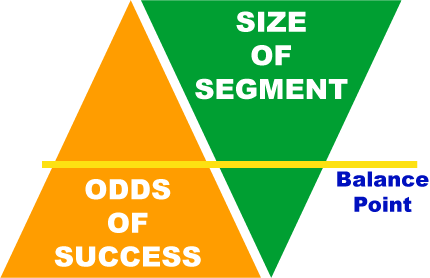Picking a target market is one of the most fundamental decisions a sales and marketing team makes. Your target market determines what products you build, where you promote them, and how you talk about them. Socratic Marketing in the budding conversation economy demands a rigorous approach to this question as part of your Big M Marketing approach..
 Picking a good target market is a balancing act. The smaller your market the higher your odds of success in targeting specific needs. However, that has to be weighed against the financial objectives of the business. You can’t get so small that you define yourself out of a job! Think of this as two forces that are inversely proportionate. Your goal is to find the right balance point.
Picking a good target market is a balancing act. The smaller your market the higher your odds of success in targeting specific needs. However, that has to be weighed against the financial objectives of the business. You can’t get so small that you define yourself out of a job! Think of this as two forces that are inversely proportionate. Your goal is to find the right balance point.
So why do so many companies get this wrong? They define markets based on granfalloons, a concept coined by Kurt Vonnegut which means “a proud and meaningless association of human beings.” For example, have you seen segmentation schemes based on geography, district size, or % of free and reduced lunch students? If you are engaging in data driven selling and/or socratic marketing these are good starting points, but they are not the most powerful way to define a market.
A far more effective approach is to define your market based on how customers think about their problems. After all, in a conversation economy their problems are the topic you will discuss with them. “Fine,” you say, “but I can’t look inside their head to see how they think, I can’t measure that to determine if the market is big enough.” Fair enough, but if they really believe something their actions will speak louder than words. You can observe where they spend money and time to tease out what their priorities are.
 On a sail there are dozens of tiny strings, tell-tales, woven into the fabric that show how the wind is moving across the face of the sail. This allows the sailors to trim the sail for optimum performance. As a metaphor this works perfectly for the concept we are after here. We can’t see how our customers think, but we can observe decisions they have already made to get a sense of it.
On a sail there are dozens of tiny strings, tell-tales, woven into the fabric that show how the wind is moving across the face of the sail. This allows the sailors to trim the sail for optimum performance. As a metaphor this works perfectly for the concept we are after here. We can’t see how our customers think, but we can observe decisions they have already made to get a sense of it.
For example, at Chancery when we released Open District in the mid 90s we decided that only large districts would be open to purchasing the product so we didn’t even bother setting up pricing for districts with fewer than 10,000 students. Almost immediately however our Sales team was telling us that smaller customers were interested. When we dug a little deeper we found that it was far more important how customers saw the role of data in decision making than how big they were. The tell-tale we used to determine this was whether or not they had hired a Database Administrator (DBA) to manage their IT systems. This allowed us to be far more precise about our targeting while expanding our footprint at the same time.
On the curriculum side you might have products that appeal to constructivists or to advocates of guided reading. For the former you might look to see if they are using any products from members of the Constructivist Consortium. For the latter it might be relevant if they have maintained a librarian on staff or if they have a bookroom. Your products might require a fair amount of teacher training – look to see how they are allocating their budgets in this area. If you are selling technology you might key in on whether or not they have installed electronic whiteboards.
The goal is to find a handful of tell-tales that marketing and sales can use to focus their efforts. Marketing can use it for list selection (only give us Districts with a DBA) and Sales can use it to qualify prospects (check – they have whiteboards).
 In the end the way you define your target market should be unique to your business but it should go much deeper than superficial indicators. Your goal is find a group of customers who are thinking about their challenges in ways that make them particularly open to the solution that you are offering.
In the end the way you define your target market should be unique to your business but it should go much deeper than superficial indicators. Your goal is find a group of customers who are thinking about their challenges in ways that make them particularly open to the solution that you are offering.
 The Education Business Blog
The Education Business Blog

